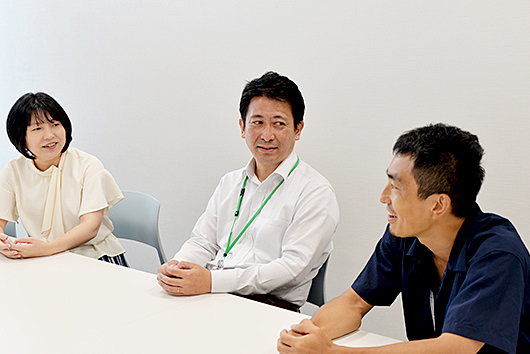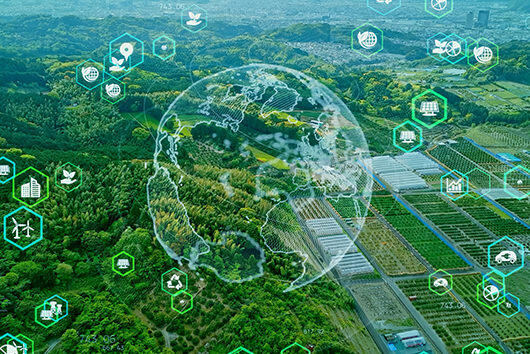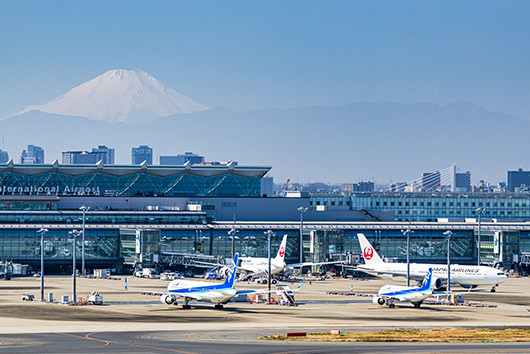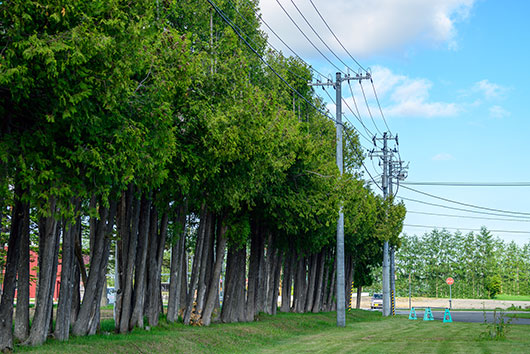In recent years, extreme weather events such as extreme heat waves and torrential rains have been occurring frequently in many parts of the world, causing severe damage such as floods and landslides. These weather disasters are believed to be caused by global warming in addition to the effects of natural variability. It is "beyond doubt" ("IPCC 6th Report") that human activities have caused global warming mainly through greenhouse gas (GHG) emissions, and how to reduce GHG emissions has become an important issue not only for governments and local public organizations but also for private companies and individual citizens. We interviewed three people who are involved in the formulation of guidelines for national climate change countermeasures and at the same time provide a wide range of support for local public organizations and corporate carbon neutrality, from strategic planning to on-site implementation: Kimiko KAJII, Chief Technical General Manager and General Project Manager of ESG Sustainable Smart City, Ryota II, General Manager of GX Promotion Dept., Social Innovation Div., and Keizo IKEDA, General Manager of Climate and Resources Policy Sec., who is also a member of this department of PACIFIC CONSULTANTS, about how companies should promote climate change countermeasures.
INDEX
- The current state of climate change and the risks to business activities
- Trends in the Japanese government and companies
- Climate change countermeasures required for companies and their challenges
- Designing business that combines climate change countermeasures with social problem solving
- What PACIFIC CONSULTANTS can do
The current state of climate change and the risks to business activities
Every year, weather disasters such as extremely high temperatures, heavy rain, strong typhoons and hurricanes, droughts, and wildfires occur frequently all over the world, and the damage they cause is becoming severe. In Japan, extreme weather phenomena such as extreme heat, heavy rain, heavy snow, and strong typhoons continue, causing great damage such as river flooding and landslides. It is becoming clear that the increase in these weather disasters is due to natural fluctuations as well as global warming, and it is predicted that if global warming progresses in the future, the risk of such weather disasters causing great damage will increase even further.
The impacts of climate change are most easily thought of in terms of water disasters and heat stroke, but they are not limited to these, and are actually quite diverse. They will have a wide range of direct and indirect effects on agriculture, forestry and fisheries, natural ecosystems, water resources, various disasters (river flooding, high tides, landslides, etc.), human health, infrastructure, economic activity, and more.
In the Sixth Assessment Report of the Intergovernmental Panel on Climate Change (IPCC), published in March 2023 for the first time in eight years, the impact of human activities (increase in man-made GHG emissions) on global warming (rise in global temperature) was changed from "highly likely" in the Fifth Assessment Report to the strongest word "unquestionable." The report also points out that the average global temperature has already risen 1.1 degrees since before the Industrial Revolution, and that in order to limit the rise to the long-term target of 1.5 degrees, a 60% reduction in GHG (a 65% reduction in CO2) is necessary by 2035. (Source: "IPCC Sixth Assessment Report, Synthesis Report, Summary for Policymakers" (Ministry of Education, Culture, Sports, Science and Technology, Ministry of Economy, Trade and Industry (METI), Japan Meteorological Agency, Ministry of the Environment))
The global response to climate change has experienced several ups and downs due to influences such as changes in administration in the United States, and now there are moves by the second Trump administration to withdraw from Paris Agreement. However, given megatrends such as the advances in scientific knowledge over the past few decades, the enormous risks posed by climate change have clearly become apparent, and we cannot afford to relax our efforts to achieve carbon neutrality by 2050.
Trends in the Japanese government and companies
Japan's full-scale efforts to combat global warming began with the Act on Promotion of Global Warming Countermeasures, enacted in 1998, following the adoption of the Kyoto Protocol in 1997. In 2005, amendments were made to require business operators that emit a certain amount of GHG to calculate, report, and disclose their emissions. In 2015, Paris Agreement *1, which agreed on the 1.5 degree target, accelerated efforts in countries around the world, and led to the expansion of ESG investment and the worldwide disclosure of information in accordance with the TCFD (Task Force on Climate-related Financial Disclosures) *2. In October 2020, the Japanese government declared that it would aim to become carbon neutral by 2050. It then announced that it would "Aim to reduce greenhouse gas by 46% from level of fiscal 2013 in fiscal 2030, and continue to challenge itself to reach a further 50%." There is a growing movement among private companies to declare "Net Zero by 2050," and as of January 31, 2025, the number of companies certified by the SBTi *3 will be 1,525 in total, including 90 companies that have declared that they will obtain certification within the next two years, making Japan the world's highest country. (Source: "Green Value Chain Platform" (Ministry of the Environment))
*1 At COP21 (the 21st Conference of the Parties to the United Nations Framework Convention on Climate Change) held in December 2015, an agreement was reached on the goal of keeping the increase in global average temperature well below 2°C above pre-industrial revolution levels, and making efforts to limit it to 1.5°C.
*2 The information on corporate responses to climate change-related risks that the TCFD recommends disclosing includes: 1) governance (what system is in place to consider these risks and how are they reflected in corporate management?); 2) strategy (how are the risks expected to impact corporate management in the short, medium, and long term?); 3) risk management (how are climate change risks assessed and reduced?); and 4) indicators and targets (what indicators are used to assess progress toward targets?).
*3 SBTi is a joint initiative establishment in 2015 by WWF, CDP, World Resources Institute (WRI), and the United Nations Global Compact. It supports companies in setting science-based targets (greenhouse gas emission reduction targets) that are consistent with the standards required by Paris Agreement, and certifies companies that are deemed to be in compliance.
Climate change countermeasures required for companies and their challenges
As natural disasters are becoming more frequent and severe, companies are now being asked not only to grasp the current state of their CO2 emissions and declare their determination and present policies to achieve net zero, but also to come up with concrete plans for how to achieve the goal and to steadily implement them. Corporate climate change measures have entered a phase in which effectiveness is increasingly important.
Climate change countermeasures can be broadly divided into mitigation and adaptation measures. Mitigation involves reducing and absorbing CO2 emissions to curb the rise in greenhouse gas concentrations that lead to climate change. Specific examples include promoting energy conservation, introducing renewable energy, promoting CO2 absorption through forest management, and capturing and utilizing CO2. Adaptation involves avoiding the risks of climate change that is already occurring, or seizing business opportunities by taking advantage of new climatic conditions. Specific examples include disaster prevention measures at factories and workplaces, and developing new products and services that take climate change into account. For both mitigation and adaptation, companies must consider and implement measures that are compatible with their company's growth.
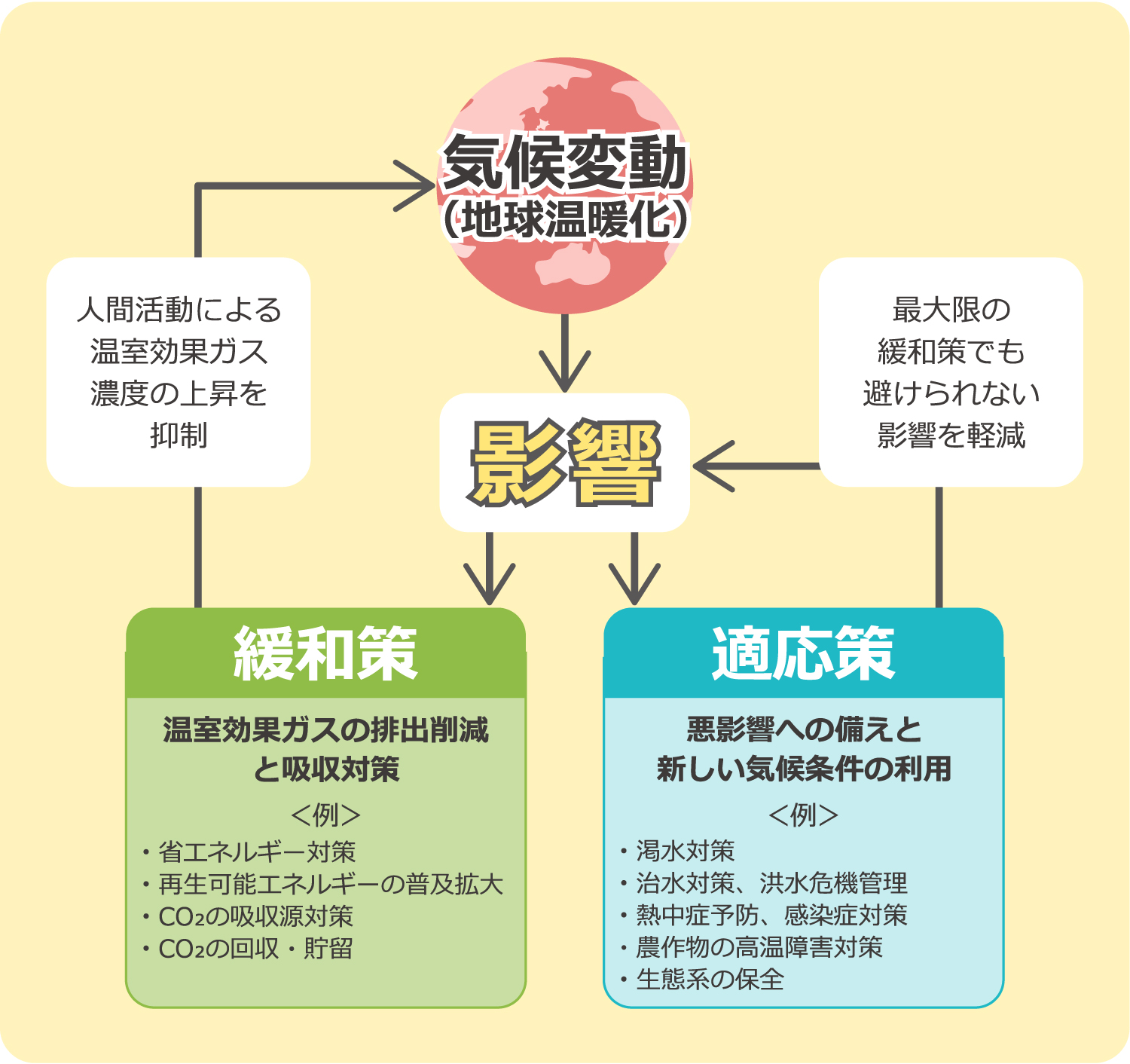
Source: Created by processing the Climate Change Observation, Prediction and Impact Assessment Integrated Report 2012 Edition (Ministry of Education, Culture, Sports, Science and Technology, Japan Meteorological Agency, Ministry of the Environment)
The problem that often stands in the way here is the issue of cost. For example, even if it is known that a certain technology clearly emits less CO2 than conventional technologies, if its introduction significantly increases costs, the choice is not easy. This has been a common issue for both mitigation and adaptation measures for over 30 years, when the need for climate change countermeasures first began to be discussed.
However, over the past few decades, technologies for renewable energy such as solar power generation and storage batteries have developed, and costs have dropped significantly compared to before, so climate change measures no longer necessarily entail a large economic burden. Rather, if implementation plans are well put together, some technologies have the potential to have a long-term cost advantage over conventional technologies. For companies, the key lies in whether they can move away from the traditional negative perception of climate change initiatives as "increasing costs" and "an obstacle to growth" and instead properly evaluate their economic viability and find ways to improve it.
Designing business that combines climate change countermeasures with social problem solving
Furthermore, while this is also related to ways to improve economic efficiency, one key point that will make it easier to advance climate change countermeasures is to cleverly design them to be compatible with solutions to other social issues.
For example, by starting with issues that are likely to have synergistic effects with solutions to problems that local communities already face, such as population decline and aging, the decline of public transportation, the degradation of forests and farmland, and the deterioration of infrastructure, incentives will naturally be created for those involved, making it easier to move forward with measures. In some cases, rather than prioritizing CO2 reduction, it may be more effective to start by considering solutions to the issues facing factories and businesses and the problems facing local residents, and then add a combination that will also help reduce CO2 emissions.
Some companies own forests and are involved in the utilization of forest resources, and proper forest management will not only increase CO2 absorption, but also conserve biodiversity by maintaining healthy forests, prevent landslides through the effects of erosion control, and even lead to an expansion of local employment through the revival of local forestry. In addition, the use of detailed forest information will make it possible to calculate the economic value of new forests based on CO2 absorption, i.e., create credits.
Introducing a microgrid that combines local renewable energy and storage batteries at your own factory or business or the area that includes it will not only reduce CO2 emissions, but also bring about synergistic effects such as securing power during power outages caused by disasters (=improving resilience) and, depending on how you do it, reducing energy costs. Considering future population decline and intensifying disasters, it is thought that the need to transition from conventional large-scale power generation systems to distributed energy systems such as microgrids that are based on the local production and consumption of renewable energy will become even more important in the future.
In the field of infrastructure, proper maintenance of aging structures is an urgent issue. However, because such structures emit a large amount of CO2 during the manufacturing stage of construction materials such as cement and steel, preventive maintenance that extends the life of existing infrastructure as much as possible (repairing while damage is still minor) can contribute to reducing CO2 emissions and also be economically efficient.
In this way, depending on how it is put together, there is the potential to simultaneously solve social issues other than climate change countermeasures and to expect economic benefits. It is important for companies to design their businesses by combining them with solutions to social issues.
What PACIFIC CONSULTANTS can do
PACIFIC CONSULTANTS has been providing various support for the national and local public organizations, as well as companies and organizations, for many years in the planning and implementation of both mitigation and adaptation measures aimed at achieving carbon neutrality. We make the most of the knowledge and personal network with academics and researchers we have accumulated through supporting national policy planning, as well as the on-site sense we have gained through supporting the implementation of measures at companies and local governments.
As for mitigation measures, first, we aim to support the decarbonization of society as a whole through consulting, and we support (1) the decarbonization of social infrastructure such as airports, ports, dams, erosion control, railways, and roads, (2) support for decarbonization at the regional level, such as decarbonization pioneering regions promoted by the government, and (3) large-scale energy projects such as offshore wind power generation, hydrogen, ammonia, and CCUS. While supporting upstream policy planning at the national level, such as the review of decarbonization policies and guidelines by relevant ministries and agencies, we also support the on-site implementation of decarbonization technologies by individual infrastructure management companies, local governments, and companies, which is a distinctive feature of our company. In addition, in the field of energy business, we have establishment and operated 19 Power Producers and Suppliers (PPS) companies, mainly through our group company Pacific Power, and are promoting new business development such as returning profits to the local community and solar PPA and VPP.
Furthermore, we are also working on supporting the creation of carbon credits, which are expected to be in high demand among companies in the future, visualizing CO2 emissions in the planning and design of civil engineering structures, and developing energy management technology.
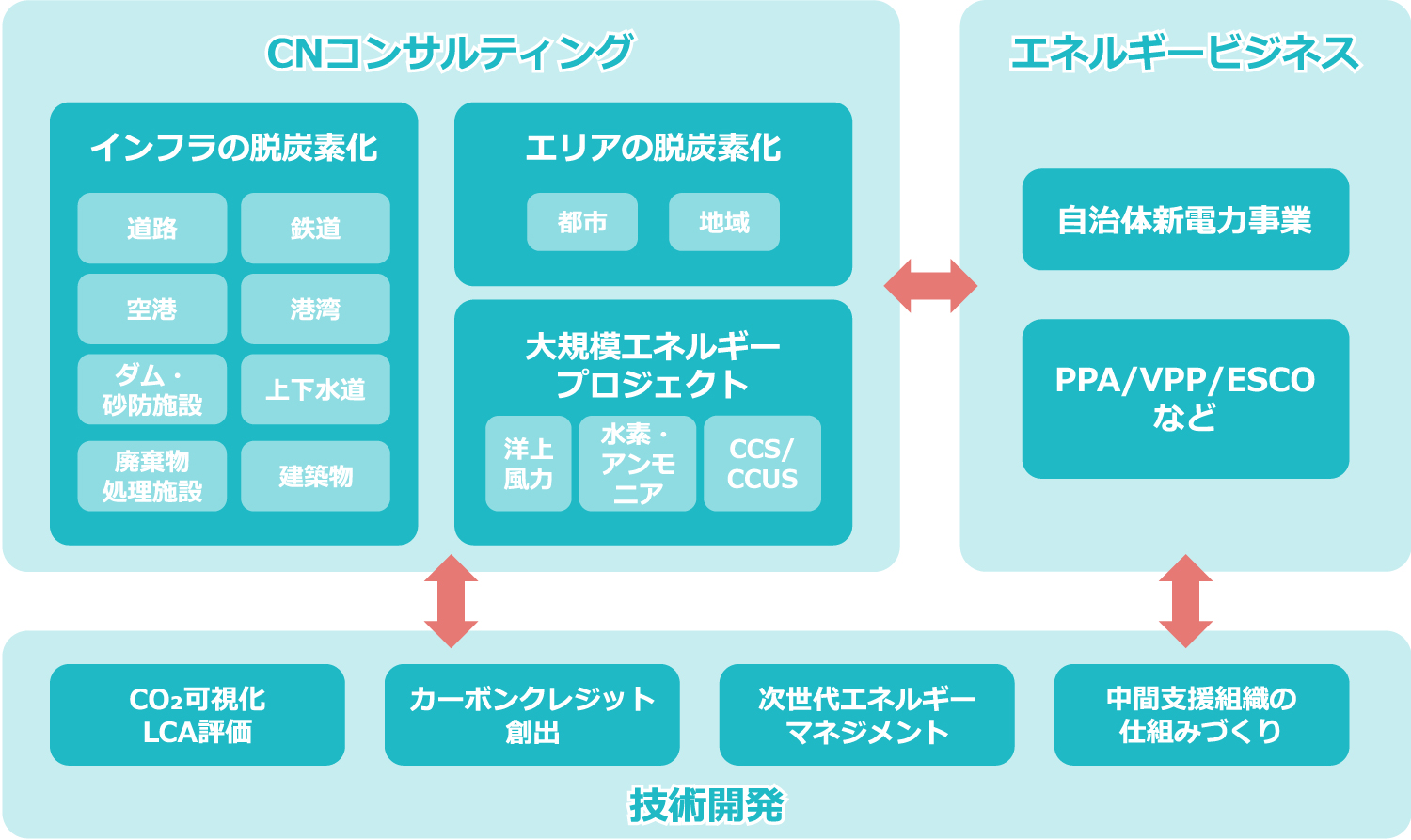
As part of adaptation measures, we are considering development plans for river, port, and other facilities that take into account future increases in precipitation and sea-level rise, as well as the necessary countermeasure technologies (both soft and hard).
For example, in ports, the perspective of "collaborative protection" is considered important, where companies that use ports for shipping, logistics, manufacturing, etc. improve facilities such as revetments under a common goal in order to strengthen disaster prevention capabilities as a whole. We support port managers and individual companies in their considerations while keeping this national approach in mind. In addition, from the perspective of water disaster risk, we provide support for companies in formulating BCPs, planning and managing tabletop exercises, and supporting the consideration of hard measures to minimize damage from floods, tsunamis, and landslides, as well as combining soft support that will help with rapid self-defense and evacuation by independently developing and providing a high-performance landslide information service with an alert function. Furthermore, in addition to supporting individual companies, we also cooperate in promoting national policies, for example by supporting the formulation of guidelines for quantitative assessment of the risk of flood damage to port-located companies due to sea level rise, tidal deviation, and increased high waves, which is one of the risk assessments required by TCFD.
As mentioned above, in supporting such corporate mitigation and adaptation measures, we do not simply look at them as climate change countermeasures, but also aim to contribute to the design of society as a whole by overlaying them with solutions to a wide range of social issues, minimizing trade-offs between environmental, economic, and social aspects and maximizing synergies as much as possible.
Supporting the consideration and implementation of climate change countermeasures, which are an extremely broad range of measures, requires not only specialized know-how and technology in a specific field, but also the comprehensive ability to conceive measures from a broad perspective and build effective plans. PACIFIC CONSULTANTS will continue to utilize its distinctive comprehensive ability to provide various support in both climate change mitigation and adaptation measures.






